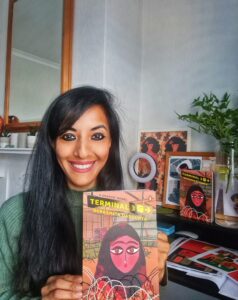Set in turbulent Kashmir, a teenage girl's wish for fulfilling her jiu-jitsu dreams forms the central plot of Dasgupta's gripping new graphic novel.

Debasmita Dasgupta's graphic novel shows the Valley's dreams and hopes hidden in layers of conflict. (L-Supplied, R- Murtaza Ali/Unsplash)
When one thinks of Kashmir, the mind evokes myriad sights and emotions — of a paradise in full bloom during summers, of a gentle breeze swaying the ripe apple orchards, of fragrant scents of flowers filling the air. And then the mind drifts towards a bitter reality — of a land strife with blood, wounded by violence, and ceaseless conflict.
True, it’s a land of paradoxes where dreams dare to thrive as much as they duck to be crushed. It is perhaps this unavoidable truth that independent filmmaker and author Debasmita Dasgupta tapped into while writing her graphic novel, Terminal 3.

‘Terminal 3’ is a poignant story set in the Valley and the central focal point is sports. (Supplied)
Despite being the centre of firestorm, Kashmir has birthed several sportspersons who have blazed the trail. Afshan Ashiq, former captain-cum-goalkeeper of the state’s women’s football team, cricketer Iqra Rasool, Wushu champion Jabeena Akhtar… the list goes on.
Yet, the spotlight on sports remains dim and that on sportswomen dimmer.
The graphic novel is set in Kashmir, with pages splashed in bright shades of pink, a complete contrast to the grim and grey colours usually associated with the turbulence in the Valley. Dasgupta’s book is about Khwab Nazir, a teen jiu-jitsu athlete, who dreams of representing India on the international sports map.
Between happiness and emptiness, desire and grief, penance, and peace, Khwab has endured. She has a dream that life will be a paradise, one day.
While the graphic novel is a work of fiction, the situation central to the plot is mostly inspired by the real circumstances in the Valley.
South First sat for a chat with Dasgupta to delve further into the unique subject of her new graphic novel.
Q. Why did you choose Kashmir as the setting for your book?
A. I have a personal connection with Kashmir, even though I am not a Kashmiri. When I was growing up, my father had a deep relationship with the state and would often take me there when I had school holidays.
When I was a child, Rafi Chacha, a shawl-seller from Kashmir, used to come to our house and sell a variety of things. I am still in touch with him. So, I have always had a soft spot for Kashmir.
Later, I worked in the development sector with different human rights organisations and had several mentors from Kashmir as well. The place has always been a point of conversation in my life. So, the setting came very naturally to me.
Q. Tell us about your central character, Khwab Nazir.
A. When I was creating Khwab’s character, I was not seeing her as someone only from Kashmir. I was perceiving her as a regular 17-year-old, who could be growing up anywhere in the world.
The things happening to her in the book are what I have seen happen to people in my life who are not from Kashmir. For instance, the Philippine woman who looked small and timid but was a fighter, mentally as well.
There is also this whole sense of having a dream and not being able to stand for it. Those vulnerabilities exist in many of us.
I see Khwab as a flawed person. She is not perfect, she has inhibitions. Khwab is scared of doing certain things, and she also feels broken. We carry these vulnerabilities within ourselves, and that, I feel, is what makes her relatable.
Q. Is Khwab’s association with jiu-jitsu a symbolic one?
A. In my mind, it is symbolic because of the people of Kashmir. As I mentioned before, the sport has got to do more with one’s state of mind rather than their physical condition.
It’s more about when you are in a conflict situation and you feel like there is no hope and only desperation. But you can come out of that situation, if you think differently.
Q. If an aspiring athlete from Kashmir reads this graphic novel, do you think Khwab could inspire them?
A. The whole idea was to show that you always have options, no matter what situation you are in. Like the part in the book where crowdfunding saves the day for Khwab.
This is the sheer beauty of the Internet, that we can be connected to strangers, and through their help, we can find a way out. Sometimes, people outside your realm can come to your aid more than those close to you.
If you have certain ambitions, there will always be people close to you who will try to tear you down. But a complete stranger might be able to be an actual support system for you.
Q. How difficult or easy was it to get under the skin of Khwab to understand fear and freedom?
A. Talking about understanding the sense of fear pertaining to the Valley, in particular, the credit for that goes to the people I spoke to from the region during my research, and my Kashmiri friends who told me what they experienced.
The part in the book where a bomb blast is mentioned is related to an incident my friend experienced in her school days. So, that section of the conflict comes from my research.
In terms of identifying with the fear and anxiety that Khwab experiences and also dealing with freedom of choice, I completely relate in general, as a woman, as somebody living in different parts of the world and facing marginalisation and discrimination.
The sense of fear and vulnerability remains inside you, and that is the part I relate to and connect the most with Khwab.
Q. Sports is not commonly associated with Kashmir.
A. Sports is an expensive affair, in general, irrespective of what sport it is. You need rigorous training to get to that international level which includes a lot of preparation.
Of course, the amount of money you need to do all this is exhorbitant. You need support not just from your family, but from the state as well to actually get into the preparation mode. Also, there is a lack of resources, which is something that does not apply just to Kashmir.
However, the fact that the state is in a conflict zone makes things more difficult for the athletes there.
There is a portion in the book, where Omar, the trainer, talks about the local academy which was washed out in the rain. It was part of my research when I found out that they don’t have proper training academies for aspiring athletes.
Most of the time, these are makeshift buildings, so how do you provide proper training?
During my research, I came across so many stories of athletes and martial artists from Kashmir, who had their own stories, but no one was talking about them.
Q. Why did you go with jiu-jitsu as the main sport for the graphic novel?

Jiu-jitsu has a symbolic connection with Khwab and Kashmir in the book. (Unsplash/Letícia Pelissari)
A. I wanted to personally explore this sport because while doing my research, I did not find Kashmiri girls really into jiu-jitsu. It was solely my creation for the book.
But I did find a lot of Kashmiri girls into martial arts.
When I was writing the story, I remembered a former colleague from the Philippines who knew jiu-jitsu. Before meeting her, I had an image of her as this big, strong, ripped woman, and here comes this shy little woman. That stunned me.
When I asked her to confirm if she actually knew the sport, she told me about the logic behind the sport. Mind over physicality.
When I was writing the story, it made me feel like this sport was symbolic of what I was trying to create. When you feel powerless, it’s not just about how strong or weak you are, but also how your mind works in such situations.
Q. How much of reality has been incorporated in your book, which is a work of fiction?
A. Every fiction is inspired by reality. Some events which transpired in your life manage to trickle down into your writing, even though it’s completely fictional.
As a layperson and a civilian, I can write only based on what I see. I also think that universal reality also applies here and not just the reality associated with Kashmir. It’s inspired by true events.
The plot is fictional, yes. But many things in my story have happened, which were based on my research. Most situations in the book, including how the training academy was affected due to the rains, are based on reality.
Q. The artwork including colour and texture is not very common in Indian graphic novels. How did you decide to use such illustrations?
A. The illustration style in my book, according to a lot of people, is something like cinematography.
As a child, I was always inspired by Jamini Roy’s paintings, which have big eyes that are heavily visible in the book. The textures you see in the hand-painted illustrations are integrated digitally.
The outfits worn by the characters are real. I photographed the Pashmina shawl, and the kaftans, which are real Kashmiri clothes, and integrated them into my story.
The illustration you see in Terminal 3 is my signature style in a way, especially the bold use of colours and the prominent facial features of the characters.
Q. What is the message you intend to convey through your graphic novel?
A. Not a message. But I want to convey a sense of a different reality which is more hopeful. I also want people to know that what we are seeing is not the full truth.
Maybe through this book, the reader can take one step ahead to find their truths. Not just about Kashmir but everything that surrounds their reality as well.
Our minds are rigged right now. Most systems are telling us certain stories and we take it as gospel and it’s probably not. There is probably another reality out there that we are not able to see.